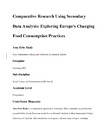| dc.description.abstract | Secondary data analysis can make it possible to research questions with high-quality data that would not otherwise be possible, especially for an early career researcher. For my PhD research, I investigated change in food consumption and associated practices across Europe. Historically, as presented by Teuteberg and Flandrin, European food consumption would have varied significantly based on region and country, with Northern Europe relying more heavily on dairy
and meat, and Southern Europe relying more on vegetables and legumes. With industrialization and globalization, I wanted to determine whether national differences were still salient or if other factors, such as class and gender, were more statistically interesting for exploring differences in consumption. Given data availability and historical food cuisines (or lack thereof), I used four waves of household budget survey data (1985-2005) from a subset of European countries, specifically Ireland, Italy, the United Kingdom, and France. Given the scope of the project, both over time and cross-nationally, it was necessary to use secondary data analysis for this research. However, there were challenges that took time to resolve. The data preparation was iterative; coding of one country often meant recoding of others. However, coding, analysis, recoding and more analysis of the data sets for equivalence and descriptive statistics exposed trends and
patterns that existed within the data sets. It became obvious that country differences were still important. What also emerged was that older people in Italy and France have very different food expenditure patterns than older people in Ireland and the United Kingdom, which indicate
different food consumption practices. These differences coincide with country differences that have been discussed in nutritional literature and named, “the Mediterranean diet” and “the French paradox”, and provide more insight into the health differences in older people that exist between the researched countries. | |


